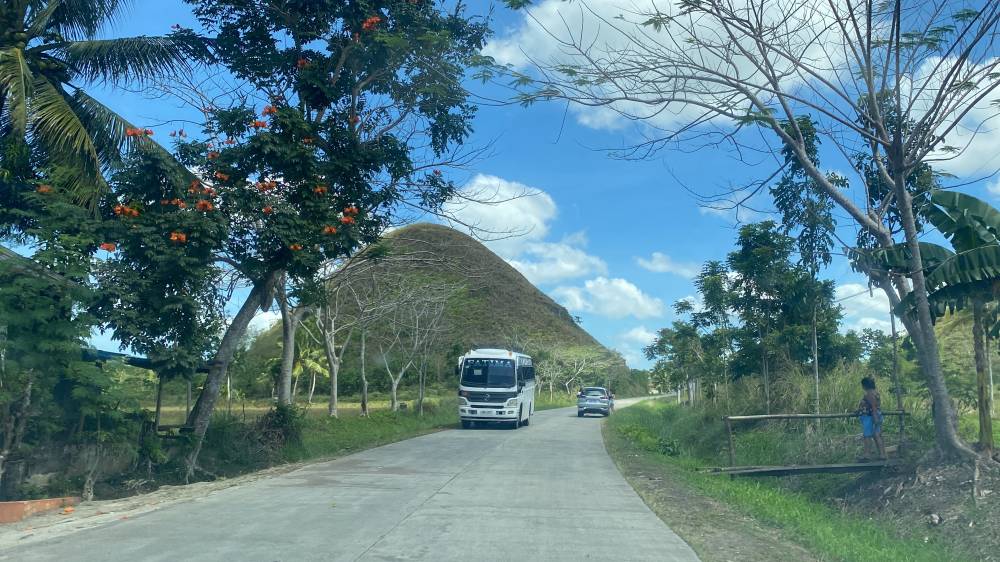Bohol execs to balance Chocolate Hills’ protection with land rights

TAGBILARAN CITY—Officials of Bohol province have vowed to help craft measures to protect the Chocolate Hills, one of the world’s natural wonders, but they have to be rules or laws that would be tailor-fit to the needs of the province.
Gov. Erico Aristotle Aumentado, speaking before the Senate Committee on Environment, Natural Resources and Climate Change, said the matter involving the Chocolate Hills is not just an environmental but also a social issue.“As public servants at the helm of the provincial government, we take our responsibility seriously to preserve the natural wonders of our province so that the next generation can enjoy them as well,” he said in his opening statement before the committee chaired by Sen. Cynthia Villar, which held the hearing at the Senate on April 3.
But he also stressed that they “should not overlook the needs and rights of the people residing and living within the protected areas and whose livelihood and means of income are dependent upon the land.”
Last month, controversies involving the Chocolate Hills erupted after two tourist-oriented businesses—Captain’s Peak Garden and Resort in Sagbayan town and Bud Agta in Carmen town—were found to have built structures within the protected area.
Authorities ordered the closure of the two establishments for lack of government permits, including environmental compliance certificates (ECCs) from the Department of Environment and Natural Resources (DENR).
The business permit of Captain’s Peak was renewed in January this year but was revoked by the municipal government last March 14. The business permit of Bud Agta was not renewed this year.
Exempted
While the Chocolate Hills are protected under the Expanded National Integrated Protected Areas System (Nipas) Act or Republic Act No. 7586, the alienable and disposable flat lands between the hills that were below 18 percent in slope were excluded from the protection law under Proclamation No. 333 issued by then President Gloria Macapagal Arroyo in February 2003. Proclamation 333, however, also required that no development should be made in lands 20 meters from the baseline of a hill; and that despite “existence of prior private rights, no activity of any kind which will alter, mutilate, deface or destroy the hills, including but not limited to quarrying, shall be allowed.”
Chocolate Hills, a geological wonder, consist of 1,776 conical mounds spread over the towns of Batuan, Bilar, Carmen, Sagbayan, Sierra Bullones and Valencia.
Tourists have been coming to the province before it was designated as a Global Geopark by the United Nations Educational, Scientific and Cultural Organization (Unesco) in May 2023 but the new status gave Bohol an “added advantage” in the world tourism industry, Aumentado admitted.
“We appreciate that in Bohol, we have active advocates for the environment, concerned citizens, civil society organizations, who keep the government in check and help shape public policy,” he added.
Aside from Villar, also present during the proceedings were Senators Nancy Binay, Loren Legarda, Rafael Tulfo and Ronald de la Rosa.
Aumentado recalled that 25 years ago, Bohol was among the top 20 poorest provinces in the country and was also a hotbed of communist insurgents.
Inclusive growth
Boholanos then made poverty reduction a primary objective through agriculture and tourism, he added.
Several years later, the governor said Bohol was excluded in the poorest provinces’ list, and was declared insurgency-free by the Armed Forces of the Philippines in 2010.
According to Aumentado, Boholanos are aiming for inclusive growth, not only for the hotels, resorts, restaurants and food chains but as well as for barangay folks, the “carenderia” (eatery) owners and other small and medium entrepreneurs.
“We don’t want to kill the goose that lays the golden egg. Much as we want to see the lives of Boholanos improve, we don’t want it to be at the cost of destroying our environment or to ‘uglify’ lovely sceneries of our province,” he said.
Aumentado concluded that “the challenge, therefore, is not just to protect our environment but to do so while nurturing the social fabric of our communities.”
The committee questioned and discussed in length why the DENR issued ECCs on some protected areas.
The DENR was asked to explain why the issuance of a Protected Area Management Board clearance was left to the discretion of barangay captains, and why ECCs were issued although there were violations committed by some entities.
Last April 1, a congressional briefing was held where Aumentado and his team were able to provide insights and position to Palawan Rep. Jose Alvarez of the committee on natural resources.Alvarez committed to work with three district representatives of Bohol: Edgar Chatto (first district), Vanessa Aumentado (second district) and Alexie Tutor (third district) in the amendments to the Nipas law and other existing guidelines to address ambiguity and gaps.
Aumentado, Board Member Jamie Villamor and other stakeholders will help in the crafting of the proposals. They also requested assistance in the lobbying to DENR on matters relating to protected areas and other environmental concerns so guidelines will fit Bohol. INQ BAGUIO CITY—The lush mountains, caves and watersheds of the Cordillera served as wellness destinations for tourists who needed the calming effect of nature as soon as all COVID-19 restrictions were lifted in 2022, officials in the region reported.
Last year, 1.63 million domestic and foreign visitors climbed or trekked the mountain region. In 2022, foreign tourist expenditures across the country rose by 1,234.2 percent, from P27.633 million in 2021 to P368.668 million, according to data provided during a tourism forum here on April 2.
This influx of tourists should encourage the private sector to finance projects that would conserve the mountain region’s ecology they frequently visit, experts said at a two-day tourism investment forum.
Developers and entrepreneurs, they said, could put up climate-responsive mountain tours, build green accommodation facilities or introduce nonpolluting electric cable car systems, partly to address the negative impact of overtourism on key destinations.
“Tourism is no longer just an economic driver,” but is also a “transformational” industry that brings attention to the problems of modern agriculture through farm tourism or draw resources to the conservation of a forest, according to Dr. Maria Cherry Lyn Rodolfo, a member of the Board of Advisors of the Dr. Andrew L Tan Center for Tourism at the Asian Institute of Management.
Footprints
The 2022 carbon dioxide emissions attributed to tourism—representing transportation by air or land and the electricity and other types of fuel used by Philippine hotels, inns and restaurants—was 6,840.07 gigagrams, Rodolfo said when she discussed the industry during the forum.
Carbon emissions, also called greenhouse gas emissions, are expelled from burnt fossil fuels like gasoline and are measured to determine a community’s or an industry’s carbon footprint (their contribution to climate change).
The 2022 number was a 75 percent increase from the 3,907.8 gigagrams recorded in 2021, she said.
About 56.6 percent of tourism-related carbon emissions are from the transport sector, while accommodation services for visitors contributed 22.4 percent emissions, Rodolfo added.
Baguio Rep. Marquez Go also addressed growing community irritation to tourists because of local issues over overcrowding and overpopulation, particularly in the summer capital where most tourists went last year (posting a total of 1.309 million guests).
Consumers’ preference
The COVID-19 pandemic has shifted consumer preference, particularly among the youth who may welcome the focus on green tourism investments, Rodolfo pointed out.
Young Filipinos and foreign tourists have actively minimized their “negative footprints” on the environment and the culture of tourist towns, she said.
Rodolfo said 76 percent of travelers polled recently “say they want to travel more sustainably over the coming 12 months this year,” although 49 percent of them believe “sustainable” tourism could be more expensive.However, 43 percent of the young travelers indicated they were willing to shoulder the cost of trips which do not harm the environment and the people in these destinations, Rodolfo said.
Tourism investments across the country amounted to P363.92 billion in 2022, Rodolfo said.
Many of these investments should improve the quality of life of people residing in these tourist towns, said Jovita Ganongan, Cordillera director of the Department of Tourism, which organized the forum.
Primed for eco-tourism investments are 15 towns of Abra province, the Benguet towns of Kapangan and Tuba, and the Hungduan and Kiangan municipalities of Ifugao province where the world renowned rice terraces are located. Also in the list are Tabuk City and Balbalan town in Kalinga province, and Paracelis town in Mountain province.
Green investments should not be limited to traditional tourism projects, said Sherida Mae Cachero, chief of investments at the Cordillera office of the National Economic Development Authority.
Given the region’s thrust to become a renewable energy powerhouse, businesses could harness the mountain’s rivers and other resources to generate electricity, which would also serve tourism, she said. INQ ILOILO CITY—The El Niño phenomenon has vastly affected the agriculture sector of Antique province, with one town already declaring a state of calamity and the provincial government expecting others localities to follow as the dry spell worsens.
Data released by the Office of Civil Defense in Western Visayas (OCD-6) showed the Antique’s agriculture sector alone already incurred P130.70 million as of April 4.
Sibalom town, which has been under a state of calamity since March 13, was dealt with losses of up to P45.79-million, with over 1,932.76 metric tons of crops destroyed and 1,344 farmers affected as of April 1. Roger Servidad, the town’s information officer, said up to 5,300 families were affected by the drought with 10 barangays also hit by fire incidents due to the extreme heat.
The municipal government has allocated P5 million for its El Niño response activities, with their priority based on which barangays have been affected, including assistance to the fire-stricken areas of the town.
“Affected barangays which are located in higher places have requested the [local government] to augment their water supply for bathing, washing dishes and gardening,” Servidad said.
He said they have requested additional assistance from the Antique provincial government.
While waiting, the municipality used its remaining resources from last year which had been set aside for other calamities.
The extreme heat also prompted cancellation of classes in the town.
Mayor Gian Carlo Occeña has issued Executive Order No. 2024-012, which suspended in-person classes from preschool to senior high school on April 4, 5 and 8. Antique Provincial Disaster Risk Reduction and Management Office chief Broderick Train said that Anini-y town is also expected to declare a state of calamity after its own municipal disaster risk reduction and management council made its recommendation on April 2.
He said 13 of 18 municipalities in Antique have been affected by the drought.
However, the number was not sufficient to meet the “30 percent affected population” threshold set by the National Disaster Risk Reduction and Management Council to declare a province-wide state of calamity, Train said. INQ CAMP GEN. ALEJO SANTOS, BULACAN—The 42-year-old wife of a fishpond operator in Hagonoy, Bulacan, and two of her relatives were arrested after they orchestrated a kidnap-for-ransom ploy involving her own son on Thursday, police said in a report on Saturday.
Police Brig. Gen. Jose Hidalgo Jr., director of the Central Luzon police, said the wife schemed with her 34-year-old female cousin and the latter’s live-in partner, a security guard, in the supposed kidnapping of her 13-year-old son, who was “rescued” after a pay-off of P550,000 in cash ransom was made in a parking lot near a mall in Plaridel town at around 4 p.m. on Friday.
On Thursday afternoon, the boy left their house to supposedly meet his classmates but failed to return home. The father sought help from Hagonoy police on Thursday night when he got a call from an unknown man who demanded P3 million in cash in exchange for his son’s freedom.
The father, along with his wife, agreed to make the payoff the next day. Unknown to the wife, her husband had alerted the police because the suspects had threatened to harm his son. Coerced
According to investigation, the son was coerced into taking part in the kidnap-for-ransom scheme.
Police said the wife planned the kidnap-for-ransom as a form of revenge against her husband over an undisclosed offense.
According to the police, the wife had told her husband that the “kidnapping” could have been hatched by fishpond workers who were laid-off.
Police were initially unsuspecting that the kidnapping was just orchestrated by the wife and discreetly tailed the teenager’s parents in their vehicle when they went to a bank in the City of Malolos and withdrew the ransom money.
The wife then dropped her husband at a mall in the city and she, with their family driver, proceeded to Calumpit town, only to turn back and proceed to a parking lot near a mall in Plaridel town. The wife then alighted from the vehicle and handed the P550,000 cash to her cousin and the latter’s partner, who were on board a black Chevrolet SLX. The duo then subsequently drove off, leaving the wife behind. The family driver, by then, had gone back to the mall and fetched the husband before they went back for the wife.
But police said they started suspecting the wife when she said she could not identify the culprits.
The police had also tailed, intercepted and arrested the wife’s cohorts. It was during questioning when the cousin revealed that it was a kidnap-for-ransom orchestrated by the wife.
The wife, who was subsequently arrested by police, and her accomplices would face charges for corruption of minor, child abuse and unjust vexation, according to Police Col. Jesus Manalo Jr., chief of the Bulacan Police Provincial Intelligence Unit. INQ

















